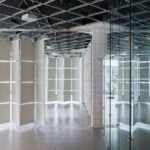Introduction
Art Hub Copenhagen, established in the Kødbyen, Copenhagen Meatpacking District since 2019, is set to relocate in the near future. Central to its ethos is the principle of reusing every element, turning the temporary perspective into a guiding dogma. The project, spearheaded by pihlmann architects + Archival Studies, embodies an innovative approach to architecture, focusing on sustainability and resource conservation.

Sustainable Architecture
The project is a response to the urgent need for sustainable practices in the construction industry. Recognizing the significant carbon footprint associated with new construction, the architects advocate for a paradigm shift towards reuse and revitalization. Art Hub Copenhagen serves as both a materialized architectural endeavor and a compelling case study, exploring methods to enhance architectural value while reducing resource consumption.
Heritage and Adaptation
Originally serving as a meat market and subsequently transformed into a bank branch, the space now hosts a modern art institution. Over time, various elements such as a weathered porch, glass cages, and a massive bank vault were added, disrupting the spatial composition. Rather than introducing new materials, the intervention aims to restore the building to its original character, peeling away layers to reveal its inherent spirit.
Architectural Archaeology
The development process resembles an archaeological excavation, dissecting the building layer by layer to uncover hidden possibilities. By rethinking and reusing existing components, the space is redefined based on its genuine atmosphere and spatial composition. This approach fosters a sensitivity to the architectural elements, unlocking their untapped functional and aesthetic potentials.

Innovative Recycling
Elements such as suspended ceiling tiles and glass cages are dismantled and repurposed into value-creating elements. Aluminum profiles from ceiling tiles are transformed into coarse-mesh filters, while white tiles are reorganized into flexible, suspended folding walls. Glass panels from the cages find new life as furniture and transparent room dividers, showcasing the innovative reuse of materials.
Conclusion
Art Hub Copenhagen exemplifies a holistic approach to sustainable architecture, where recycling becomes a catalyst for architectural form and intention. By conserving resources and preserving the distinctive character of Kødbyen, the project sets a precedent for rethinking recycling in architecture. Through innovative reuse and adaptation, Art Hub Copenhagen paves the way for a more sustainable future in architectural design.










